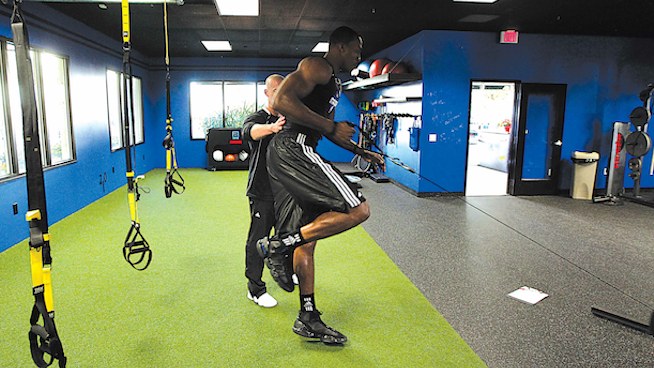Is It Better to Perform Exercises One Arm or Leg at a Time?
No matter how much information comes out on the benefits of unilateral exercises (i.e., single-arm or leg exercises), there will always be meatheads who refuse to complete any exercise with only one foot on the ground or one hand on the bar. Then, when you give them any significant load on one limb and ask them to stand on one foot or make an athletic move, they look they are having a seizure.
The same goes for the other side of the spectrum, with “functional” athletes/coaches/movie star wannabes, who argue that any movement not balancing on an Airex pad like a ballerina is a waste of time. But then when you ask them to pick up something heavy, they buckle and collapse.
Both bilateral exercises (higher overall force production, shorter learning curve, less stability required, etc.) and unilateral exercises (more joint friendly, more core activation, more stability required, etc.) have obvious benefits. For the most part, many coaches/lifters/trainees acknowledge this and now use a mix of both within their programming.
But misconceptions still persist: that bilaterals should be your main lifts focused on strength and power development and that unilaterals should be viewed as assistant lifts focused on size, capacity and stability.
This leaves a lot of strength, size and performance gains on the table. If you want to more quickly build a body defined by strength, power and athleticism (as well as slabs of muscle), you need to forget the above “rule” and cycle between bilateral and unilateral lifts as your main and assistant lifts.
WATCH: Mike Boyle’s Favorite Single-Leg Exercises
Main Movements
The primary goal of your main movements should be to express as much power and force production as possible. That is, you should either move a relatively lighter weight as quickly as possible (peak power production) or you should move as much weight as possible (peak force production). For this purpose, your main movements come first in your program when your central nervous system is fresh, ready to go and fatigue is not a factor.
Program more sets, fewer reps and longer rest periods to ensure that every rep is quality, and that you can continue to be as explosive and produce as much force as you can.
Your main movements are performed with 4-10 sets of 1-5 reps with at least 3 minutes of rest between sets. The rest between sets can be completed by performing a non-competing exercise in order to maximize time and training density.
Some of the best exercises for main movements include:
Lower-Body Bilateral
- Vertical Jump Variations (In-Place Jump, Box Jump, etc.)
- Broad Jump
- Barbell Squat Variations (Back Squat, Front Squat)
- Deadlift Variations (Conventional, Sumo, Trap Bar, Rack Pull)
Lower-Body Unilateral
- Single-Leg Jump Variations (Rear Foot Elevated Jumps, Step-Up Jumps, In-Place Single-Leg Hops, etc.)
- Bound Variations (Forward Bounds, Lateral Bounds, Triple Hops, etc.)
- Rear-Foot-Elevated Split-Squats (Bulgarian Split Squats)
- Split-Squats
- Barbell Lunge Variations (Front Squat Grip Reverse Lunges, Lateral Lunges, Forward Lunges, etc.)
Upper-Body Bilateral
- Med Ball Chest Pass
- Explosive Push-Ups
- Barbell Bench Press Variations (Flat, Incline, Decline, Pin Press, etc.)
- Vertical Pull Variations (Pull-Up, Chin-Up, Neutral Grip, etc.)
Upper-Body Unilateral
- Med Ball Shot Put
- Single-Arm Dumbbell Push Jerk
- Single-Arm Dumbbell Press Variations (Flat Bench, Incline Bench, Seated Overhead Press, etc.)
- Single-Arm Horizontal Pulls (Single Arm Inverted Rows, Bent Over DB Rows, Single Arm Chest Supported Rows)
RELATED: 5 Hacks to Solve Problems With Single-Leg Exercises
Assistance Movements
The primary goal of your assistant movements is to continue to move as much weight as possible, while creating a more favorable adaptation for hypertrophy (mechanical and metabolic stress) as well as challenging stability and movement in a fatigued state.
The best ways to increase these stresses include increasing loads, again still moving as much weight as possible for the given movement and number of reps), increasing time under tension and decreasing rest periods. This combination brings on fatigue, which is good as long as the training is kept safe. You need to perform and move well when fatigued—in all patterns!
However, fatigue and maximal loading do not mix well. That’s why your assistant movements are completed with submaximal loads. And because the goal is to accumulate sufficient stress (but not pass a safe threshold), you will do a higher total volume (fewer sets but more reps) and have shorter rest periods.
Your assistant movements should be performed with 2-4 sets of 6-12 reps with 30-90 seconds of rest between sets. Again with the assistant movements, the rest between sets can be completed by performing a non-competing exercise.
Some of the best exercises for assistant movements include:
Lower-Body Bilateral
- Goblet Squats
- Offset KB Squats
- Romanian Deadlifts
- Suitcase Deadlifts
Lower-Body Unilateral
- Dumbbell Lunge Variations (Walking, Reverse, Forward, Lateral, Goblet Grip, Offset Grip, etc.)
- Step-Up Variations (Barbell or DB)
- Single-Leg Deadlift Variations (Barbell SL RDL, DB SL RDL, etc.)
Upper-Body Bilateral
- Close-Grip Bench Variations (Flat, Incline, Decline, etc.)
- Push-Up Variations (Regular, with Chains, Incline, etc.)
- Inverted Rows
- Seated Cable Rows
Upper-Body Unilateral
- Single-Arm Push-Ups
- Single-Arm Overhead Presses
- Single-Arm Cable Rows
- Single-Arm Cable Pulldowns
Putting It All Together
To build a strong, muscular and athletic physique that both looks good and performs well, athletes should take full advantage of the strength and size benefits of both bilateral and unilateral movements.
What follows is a sample four-day program that cycles bilateral and unilateral movements between main and assistant movements for a given session. Go as heavy as possible maintaining form within the parameters given.
Day 1 Lower
- 1a) Deadlift – 5×3; rest for 60 seconds before moving on to your next exercise
- 1b) Plank – 5×20-30 seconds
- 2a) Reverse Dumbbell Lunge – 4×6 each side; rest for 45 seconds before moving on to your next exercise
- 2b) Glute Ham Raise – 4×8
- 3a) Goblet-Grip Lateral Lunge – 2-3×8 each side; rest for 30 seconds before moving on to your next exercise
- 3b) Anti-Rotation Press – 2-3×10 each side
Day 2 Upper
- 1a) Single-Arm Incline Dumbbell Bench Press – 5×4 each side; rest for 60 seconds before moving on to your next exercise
- 1b) Pull-Up – 5×5
- 2a) Band-Resisted Push-Up – 4×8; rest for 45 seconds before moving on to your next exercise
- 2b) Single-Arm Cable Row – 4×8 each side
- 3a) Side Plank – 2-3×20-30 seconds each side; rest for 30 seconds before moving on to your next exercise
- 3b) TRX Fallout – 2-3×10
Day 3 Lower
- 1a) Front Squat Grip Reverse Lunge – 5×4 each side; rest for 60 seconds before moving on to your next exercise
- 1b) Anti-Rotation Press – 5×8 each side
- 2a) RDL – 4×8; rest for 45 seconds before moving on to your next exercise
- 2b) Dumbbell Step-Up – 4×8 each side
- 3a) Goblet Squat – 2-3×8-10; rest for 30 seconds before moving on to your next exercise
- 3b) Overhead Anti-Extension Cable Press – 2-3×8
Day 4 Upper
- 1a) Pin Press – 5×3; rest for 60 seconds before moving on to your next exercise
- 1b) Single-Arm Dumbbell Bent-Over Row – 5×5 each side
- 2a) Single-Arm Overhead Dumbbell Press – 4×8 each side; rest for 45 seconds before moving on to your next exercise
- 2b) TRX Inverted Row – 4×8
- 3a) Side Plank – 2-3×20-30 seconds each side; rest for 30 seconds before moving on to your next exercise
- 3b) Deadbug – 2-3×6 each side
RECOMMENDED FOR YOU
MOST POPULAR
Is It Better to Perform Exercises One Arm or Leg at a Time?
No matter how much information comes out on the benefits of unilateral exercises (i.e., single-arm or leg exercises), there will always be meatheads who refuse to complete any exercise with only one foot on the ground or one hand on the bar. Then, when you give them any significant load on one limb and ask them to stand on one foot or make an athletic move, they look they are having a seizure.
The same goes for the other side of the spectrum, with “functional” athletes/coaches/movie star wannabes, who argue that any movement not balancing on an Airex pad like a ballerina is a waste of time. But then when you ask them to pick up something heavy, they buckle and collapse.
Both bilateral exercises (higher overall force production, shorter learning curve, less stability required, etc.) and unilateral exercises (more joint friendly, more core activation, more stability required, etc.) have obvious benefits. For the most part, many coaches/lifters/trainees acknowledge this and now use a mix of both within their programming.
But misconceptions still persist: that bilaterals should be your main lifts focused on strength and power development and that unilaterals should be viewed as assistant lifts focused on size, capacity and stability.
This leaves a lot of strength, size and performance gains on the table. If you want to more quickly build a body defined by strength, power and athleticism (as well as slabs of muscle), you need to forget the above “rule” and cycle between bilateral and unilateral lifts as your main and assistant lifts.
WATCH: Mike Boyle’s Favorite Single-Leg Exercises
Main Movements
The primary goal of your main movements should be to express as much power and force production as possible. That is, you should either move a relatively lighter weight as quickly as possible (peak power production) or you should move as much weight as possible (peak force production). For this purpose, your main movements come first in your program when your central nervous system is fresh, ready to go and fatigue is not a factor.
Program more sets, fewer reps and longer rest periods to ensure that every rep is quality, and that you can continue to be as explosive and produce as much force as you can.
Your main movements are performed with 4-10 sets of 1-5 reps with at least 3 minutes of rest between sets. The rest between sets can be completed by performing a non-competing exercise in order to maximize time and training density.
Some of the best exercises for main movements include:
Lower-Body Bilateral
- Vertical Jump Variations (In-Place Jump, Box Jump, etc.)
- Broad Jump
- Barbell Squat Variations (Back Squat, Front Squat)
- Deadlift Variations (Conventional, Sumo, Trap Bar, Rack Pull)
Lower-Body Unilateral
- Single-Leg Jump Variations (Rear Foot Elevated Jumps, Step-Up Jumps, In-Place Single-Leg Hops, etc.)
- Bound Variations (Forward Bounds, Lateral Bounds, Triple Hops, etc.)
- Rear-Foot-Elevated Split-Squats (Bulgarian Split Squats)
- Split-Squats
- Barbell Lunge Variations (Front Squat Grip Reverse Lunges, Lateral Lunges, Forward Lunges, etc.)
Upper-Body Bilateral
- Med Ball Chest Pass
- Explosive Push-Ups
- Barbell Bench Press Variations (Flat, Incline, Decline, Pin Press, etc.)
- Vertical Pull Variations (Pull-Up, Chin-Up, Neutral Grip, etc.)
Upper-Body Unilateral
- Med Ball Shot Put
- Single-Arm Dumbbell Push Jerk
- Single-Arm Dumbbell Press Variations (Flat Bench, Incline Bench, Seated Overhead Press, etc.)
- Single-Arm Horizontal Pulls (Single Arm Inverted Rows, Bent Over DB Rows, Single Arm Chest Supported Rows)
RELATED: 5 Hacks to Solve Problems With Single-Leg Exercises
Assistance Movements
The primary goal of your assistant movements is to continue to move as much weight as possible, while creating a more favorable adaptation for hypertrophy (mechanical and metabolic stress) as well as challenging stability and movement in a fatigued state.
The best ways to increase these stresses include increasing loads, again still moving as much weight as possible for the given movement and number of reps), increasing time under tension and decreasing rest periods. This combination brings on fatigue, which is good as long as the training is kept safe. You need to perform and move well when fatigued—in all patterns!
However, fatigue and maximal loading do not mix well. That’s why your assistant movements are completed with submaximal loads. And because the goal is to accumulate sufficient stress (but not pass a safe threshold), you will do a higher total volume (fewer sets but more reps) and have shorter rest periods.
Your assistant movements should be performed with 2-4 sets of 6-12 reps with 30-90 seconds of rest between sets. Again with the assistant movements, the rest between sets can be completed by performing a non-competing exercise.
Some of the best exercises for assistant movements include:
Lower-Body Bilateral
- Goblet Squats
- Offset KB Squats
- Romanian Deadlifts
- Suitcase Deadlifts
Lower-Body Unilateral
- Dumbbell Lunge Variations (Walking, Reverse, Forward, Lateral, Goblet Grip, Offset Grip, etc.)
- Step-Up Variations (Barbell or DB)
- Single-Leg Deadlift Variations (Barbell SL RDL, DB SL RDL, etc.)
Upper-Body Bilateral
- Close-Grip Bench Variations (Flat, Incline, Decline, etc.)
- Push-Up Variations (Regular, with Chains, Incline, etc.)
- Inverted Rows
- Seated Cable Rows
Upper-Body Unilateral
- Single-Arm Push-Ups
- Single-Arm Overhead Presses
- Single-Arm Cable Rows
- Single-Arm Cable Pulldowns
Putting It All Together
To build a strong, muscular and athletic physique that both looks good and performs well, athletes should take full advantage of the strength and size benefits of both bilateral and unilateral movements.
What follows is a sample four-day program that cycles bilateral and unilateral movements between main and assistant movements for a given session. Go as heavy as possible maintaining form within the parameters given.
Day 1 Lower
- 1a) Deadlift – 5×3; rest for 60 seconds before moving on to your next exercise
- 1b) Plank – 5×20-30 seconds
- 2a) Reverse Dumbbell Lunge – 4×6 each side; rest for 45 seconds before moving on to your next exercise
- 2b) Glute Ham Raise – 4×8
- 3a) Goblet-Grip Lateral Lunge – 2-3×8 each side; rest for 30 seconds before moving on to your next exercise
- 3b) Anti-Rotation Press – 2-3×10 each side
Day 2 Upper
- 1a) Single-Arm Incline Dumbbell Bench Press – 5×4 each side; rest for 60 seconds before moving on to your next exercise
- 1b) Pull-Up – 5×5
- 2a) Band-Resisted Push-Up – 4×8; rest for 45 seconds before moving on to your next exercise
- 2b) Single-Arm Cable Row – 4×8 each side
- 3a) Side Plank – 2-3×20-30 seconds each side; rest for 30 seconds before moving on to your next exercise
- 3b) TRX Fallout – 2-3×10
Day 3 Lower
- 1a) Front Squat Grip Reverse Lunge – 5×4 each side; rest for 60 seconds before moving on to your next exercise
- 1b) Anti-Rotation Press – 5×8 each side
- 2a) RDL – 4×8; rest for 45 seconds before moving on to your next exercise
- 2b) Dumbbell Step-Up – 4×8 each side
- 3a) Goblet Squat – 2-3×8-10; rest for 30 seconds before moving on to your next exercise
- 3b) Overhead Anti-Extension Cable Press – 2-3×8
Day 4 Upper
- 1a) Pin Press – 5×3; rest for 60 seconds before moving on to your next exercise
- 1b) Single-Arm Dumbbell Bent-Over Row – 5×5 each side
- 2a) Single-Arm Overhead Dumbbell Press – 4×8 each side; rest for 45 seconds before moving on to your next exercise
- 2b) TRX Inverted Row – 4×8
- 3a) Side Plank – 2-3×20-30 seconds each side; rest for 30 seconds before moving on to your next exercise
- 3b) Deadbug – 2-3×6 each side











